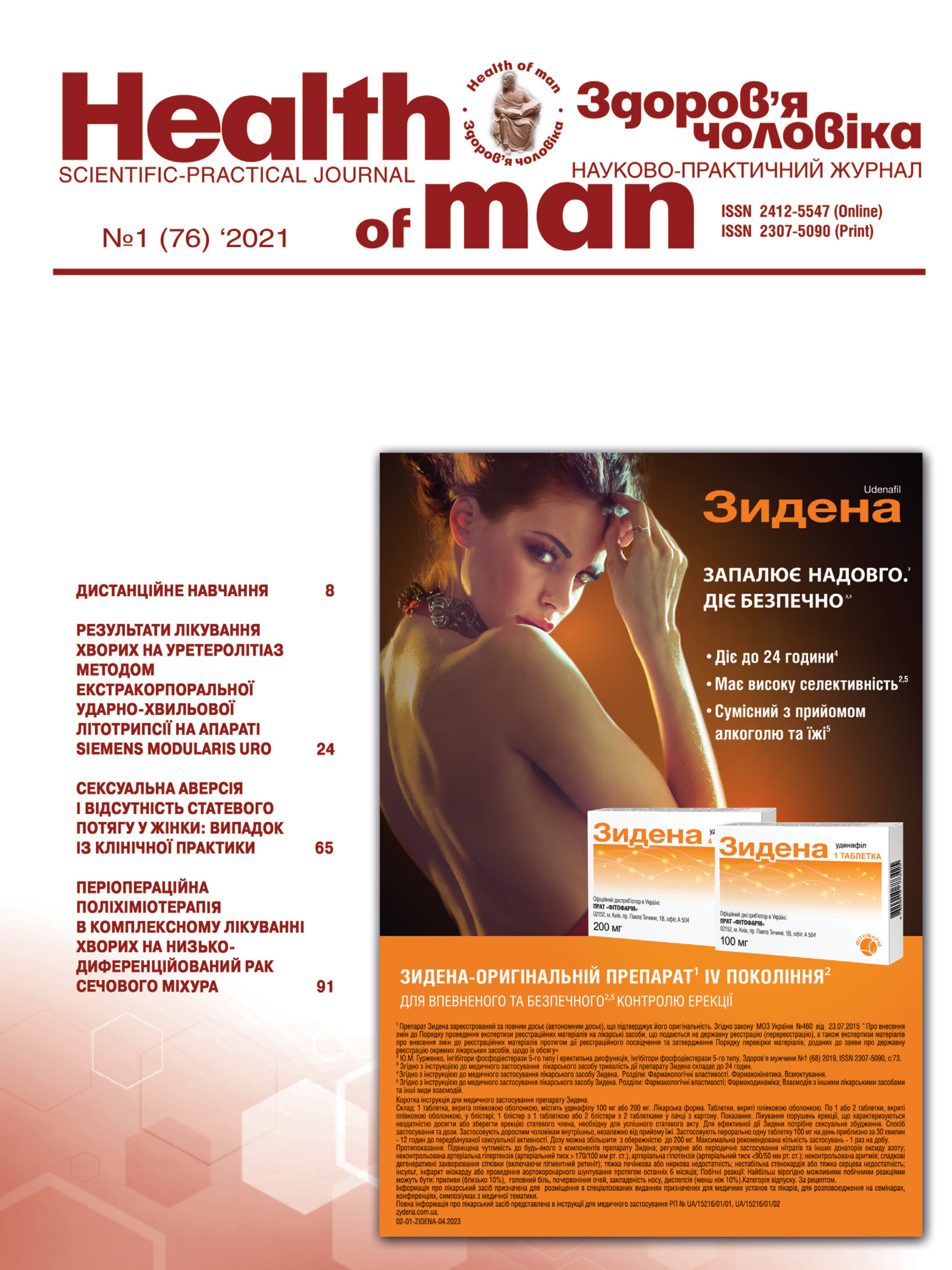Results of Treatment of Patients with Ureterolithiasis by Extracorporal Shock Wave Lithotripsy on Siemens Modularis Uro
##plugins.themes.bootstrap3.article.main##
Abstract
Extracorporeal shock wave lithotripsy (ESWL) has been used in the treatment of urolithiasis since 1980s. The method has proven to be effective and minimally invasive, but in last years the effectiveness of the method has decreased significantly from 90 % to 60 %. Studying of the causes of this phenomenon and methods of improving treatment outcomes are important problems of modern minimally invasive urology.
The objective: to evaluate the effectiveness of the application of ESWL on Siemens Modularis Uro in the treatment of patients with ureterolithiasis.
Materials and methods. ESWL was performed in 662 patients with ureteral stones ranging in size from 5 mm to 19 mm on Siemens Modularis Uro.
Results. In 95.01 % of cases, the urinary tract was free of stones by the method of ESWL, the removal of stones in 1 session occurred in 376 (56.8 %) patients, with repeated – in 253 (43.2 %) patients. In 33 (4.99 %) patients the result of ESWL was unsatisfactory, fragmentation or elimination of stone fragments did not occur and for these patients ureteroscopy (ureterolithotripsy) was performed as second stage of treatment. During endoscopic intervention in 78.8 % of patients the fragmentation was satisfactory (fragments were smaller than 4 mm), but the elimination of fragments did not occur due to changes of the wall of the ureter in the area of its primary location. The overall rate of stone fragmentation after ESWL sessions in the patients in the trial was 98.94 %. Conducting ESWL with the proposed parameters did not affect the effectiveness of the method (p>0.1), but allowed to significantly increase the life of medical equipment. No complications directly related to lithotripsy were detected.
Conclusion. The obtained results make possible to consider ESWL as a priority method of treatment for patients with ureteral stones up to 15 mm, taking into account the risk factors of inefficiency.
##plugins.themes.bootstrap3.article.details##

This work is licensed under a Creative Commons Attribution 4.0 International License.
Authors retain the copyright and grant the journal the first publication of original scientific articles under the Creative Commons Attribution 4.0 International License, which allows others to distribute work with acknowledgment of authorship and first publication in this journal.
References
Liu Yu, Chen Yu, Liao B, et al. (2018). Epidemiology of urolithiasis in Asia. Asian. J. Urol. 5(4):205–214.
Banov P, Ceban E. (2017). The efficacy of metaphylaxis in treatment of recurrent urolithiasis. J. Med. Life. 10(3):188–193.
Siener R, Buchholz N, Daudon M, et al. (2016). Quality Assessment of Urinary Stone Analysis: Results of a Multicenter Study of Laboratories in Europe. PLoS One. 11(6):e0156606.
Ordon M, Andonian S, Blew B, et al. (2015). CUA Guideline: Management of ureteral calculi Can. Urol. Assoc. J. 9(11-12):E837–E851.
Zumstein V, Betschart P, Abt D, et al. (2018). Surgical management of urolithiasis – a systematic analysis of available guidelines. BMC. Urol. 18:25.
Choi JD, Seo SIl, Kwon J, et al. (2019). Laparoscopic Ureterolithotomy vs Ureteroscopic Lithotripsy for Large Ureteral Stones. JSLS. 23(2):e2019.00008.
Binbin J, Shicong L, Xin X, et al. (2019). The efficacy of flexible ureteroscopy lithotripsy and miniaturized percutaneous nephrolithotomy for the treatment of renal and proximal ureteral calculi of ≤2 cm A retrospective study. Med. (Baltimore). 98(11):e14535.
Torricelli FC, Monga M, Marchini GS, et al. (2016). Semi-rigid ureteroscopic lithotripsy versus laparoscopic ureterolithotomy for large upper ureteral stones: a meta – analysis of randomized controlled trials. Int. Braz. J. Urol. 42(4):645–654.
Dell’atti L, Papa S. (2016). Ten-year experience in the management of distal ureteral stones greater than 10 mm in size G Chir. 37(1):27–30.
Şahin S, Aras B, Ekşi M, et al. (2016). Laparoscopic Ureterolithotomy JSLS. 20(1):e2016.00004.
Shinde S, Al Balushi Y, Hossny M, et al. (2018). Factors Affecting the Outcome of Extracorporeal Shockwave Lithotripsy in Urinary Stone Treatment. Oman Med. J. 33(3): 209–217.
Lim KH, Jung J-H, Kwon JH, et al. (2015). Can stone density on plain radiography predict the outcome of extracorporeal shockwave lithotripsy for ureteral stones? Korean J. Urol. 56(1):56–62.
Pricop C, Radavoi GD, Puia D, et al. (2019). obesity: a delicate issue choosing the eswl treatment for patients with kidney and ureteral stones? Acta. Endocrinol. (Buchar). 15(1):133–138.
Petrides N, Ismail S, Anjum F, et al. (2020). How to maximize the efficacy of shockwave lithotripsy. Turk J. Urol. 46(Suppl 1):S19–S26.
Legemate JD, Wijnstok NJ, Matsuda T, et al. (2017). Characteristics and outcomes of ureteroscopic treatment in 2650 patients with impacted ureteral stones. World J. Urol. 35(10):1497–1506.
Türk C, Neisius A, Petrik A, et al. (2020). EAU Guidelines. Edn. presented at the EAU Annual Congress Amsterdam. Netherlands: EAU Guidelines Office. URL: http://uroweb.org/guidelines/compilations-of-all-guidelines/





